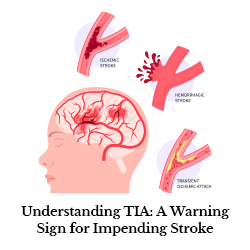
What is TIA?
TIA stands for Transient Ischemic Attack (TIA), often referred to as a “mini stroke,” occurs when there’s a temporary blockage of blood flow to the brain. Unlike a stroke, a TIA episode resolves within minutes or hours, leaving no permanent damage. However, it is a critical warning sign of a potential stroke.
Despite its transient nature, TIA carries significant importance due to its potential to lead to a full-blown stroke within 48 hours. Understanding the symptoms, risk factors, and the urgency of timely evaluation and TIA treatment is paramount in preventing devastating consequences. In this blog, we delve into the intricacies of TIA, shedding light on its clinical significance and the steps individuals can take to mitigate the risk of stroke.
Symptoms of TIA
Common TIA symptoms include sudden vision changes, slurred speech, and numbness on one side of the body. Women might experience unique signs, such as confusion or visual TIA symptoms. These symptoms of a TIA often overlap with a stroke, but TIAs do not cause lasting effects.
Speech Disturbances:
One of the most common symptoms of TIA is speech disturbance. This may manifest as slurring of speech, difficulty articulating words, or trouble understanding language. Individuals experiencing TIA-related speech disturbances may find it challenging to communicate effectively, which can be alarming for both the affected individual and those around them.
Sensory Abnormalities:
Numbness or weakness, particularly on one side of the body, is a classic symptom of TIA. This sensory abnormality often presents suddenly and may affect the face, arm, or leg. Individuals may notice a tingling sensation or a loss of feeling in the affected limb, signaling potential disruption in blood flow to the corresponding area of the brain.
Visual Disturbances:
Visual disturbances are another hallmark of TIA. These may include blurred vision, double vision, or partial loss of vision in one eye or a portion of the visual field. Visual symptoms can be disorienting and may interfere with daily activities such as reading, driving, or navigating the environment.
Imbalance and Coordination Issues:
TIA can disrupt the brain’s ability to coordinate movement and maintain balance. Individuals may experience dizziness, vertigo, or a feeling of unsteadiness. Incoordination and difficulty walking in a straight line may also be observed, posing a risk for falls and injury.
Other Symptoms:
In addition to the aforementioned symptoms, individuals with TIA may experience confusion, memory lapses, or sudden onset of severe headache. These symptoms can vary in intensity and duration but should always prompt immediate medical attention to rule out underlying vascular pathology and prevent progression to stroke.
The Emergency of Recognition and Treatment
While the symptoms of TIA may resolve spontaneously, they should never be overlooked. TIA serves as a medical emergency and a forewarning of an impending stroke. Shockingly, statistics reveal that approximately one in three individuals who experience TIA will suffer a stroke within a year, with the highest risk looming within the first 48 hours post-TIA episode. Swift Action Saves Lives: The Importance of Timely Evaluation and Treatment.
The key to mitigating the risk of stroke following a TIA lies in prompt medical intervention. Timely evaluation by healthcare professionals neurology specialists from a neuro speciality hospital can facilitate the identification of underlying causes and initiation of appropriate preventive measures. Diagnostic procedures such as imaging studies and blood tests aid in determining the extent of vascular involvement and underlying pathology.
Raising awareness about the signs, symptoms, and implications of TIA is essential in empowering individuals to take proactive steps towards stroke prevention.
Education regarding the importance of seeking immediate medical attention upon experiencing TIA symptoms can significantly impact outcomes and avert potential disabilities or fatalities.
If you experience mini stroke symptoms, seek medical attention immediately. Early intervention can prevent a full-blown stroke. Treatment may involve medication or lifestyle changes to address causes of TIA, such as high blood pressure or diabetes.
Conclusion
In conclusion, TIA serves as a critical warning sign for an impending stroke, necessitating swift action and proactive measures. Recognizing the symptoms of TIA, understanding its significance, and seeking prompt medical evaluation from a best hospital are paramount in averting the catastrophic consequences of stroke. By prioritizing brain health, adopting preventive strategies, and advocating for timely intervention, individuals can significantly reduce the risk of stroke and safeguard their well-being.
Remember, when it comes to TIA and stroke, time is of the essence. Act swiftly, seek medical attention promptly, and embrace a proactive approach towards brain health. Your actions today could save a life tomorrow.
Dr. Surbhi C
Consultant Neurologist


